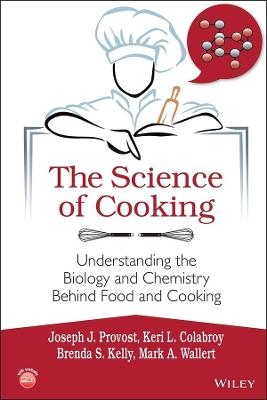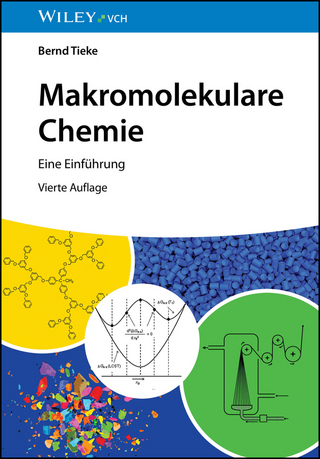
The Science of Cooking
John Wiley & Sons Inc (Verlag)
978-1-118-67420-8 (ISBN)
The Science of Cooking The first textbook that teaches biology and chemistry through the enjoyable and rewarding means of cooking
The Science of Cooking is a textbook designed for nonscience majors or liberal studies science courses, that covers a range of scientific principles of food, cooking, and the science of taste and smell. It is accompanied by a companion website for students and adopting faculty. It details over 30 guided inquiry activities covering science basics and food-focused topics, and also includes a series of laboratory experiments that can be conducted in a traditional laboratory format, experiments that can be conducted in a large class format, and take-home experiments that can be completed with minimal equipment at the student’s home. Examples of these engaging and applicable experiments include fermentation, cheese and ice cream making, baking the best cookies, how to brown food faster, and analyzing food components. They are especially useful as a tool for teaching hypothesis design and the scientific process.
The early chapters of the text serve as an introduction to necessary biology and chemistry fundamentals, such as molecular structure, chemical bonding, and cell theory, while food-based chapters cover:
Dairy products (milk, ice cream, foams, and cheeses)
Fruits and vegetables
Meat and fish
Bread
Spices and herbs
Beer and wine
Chocolate and candies
The Science of Cooking presents chemistry and biology concepts in an easy-to-understand way that demystifies many basic scientific principles. For those interested in learning more science behind cooking, this book delves into curious scientific applications and topics. This unique approach offers an excellent way for chemistry, biology, or biochemistry departments to bring new students of all levels and majors into their classrooms.
Joseph J. Provost, PhD, is a professor of chemistry and biochemistry at the University of San Diego, USA. He has helped create and teach a science of cooking class and taught small and large classes. Provost has served on educational and professional development committees for the American Society for Biochemistry and Molecular Biology, Council on Undergraduate Research, and the American Chemical Society while teaching biochemistry, biotechnology, and introductory chemistry laboratories and conducting lectures. He continues a partnership with Mark A. Wallert on lung cancer research. Keri L. Colabroy, PhD, is an associate professor of chemistry at Muhlenberg College in Allentown, Pennsylvania, USA, where she created and teaches a course on kitchen chemistry for nonscience majors. In addition to teaching, Colabroy maintains an active undergraduate research lab in enzymology, serves as coordinator for undergraduate research at the college, and participates on the Council on Undergraduate Research in the Division of Chemistry. Brenda S. Kelly, PhD, is an associate professor of biology and chemistry at Gustavus Adolphus College in St. Peter, Minnesota, USA. In addition to talking with her students about cooking as one big science experiment, Kelly teaches courses in biochemistry and organic chemistry and has an active undergraduate research lab where she engages her students in research questions related to protein structure and function. Mark A. Wallert, PhD, is an associate professor of biology at Bemidji State University in Bemidji, Minnesota, USA. Mark was an inaugural member of Project Kaleidoscope Faculty for the twenty-first century in 1994 and has worked to integrate inquiry-driven, research-based laboratories into all of his courses.
Preface xi
About the Authors xiii
About the Companion Website xvii
1 The Science of Food and Cooking: Macromolecules 1
1.1 Introduction 1
1.2 Fundamentals of Food and Cooking 3
1.3 The Real Shape of Food: Molecular Basics 6
References 54
2 The Science of Taste and Smell 55
2.1 Introduction 55
2.2 The Physiology of Taste, Smell, and Flavor 55
2.3 Gustation: The Basics of Taste 58
2.4 Why Do We Taste? 63
2.5 The Diversity of Tastants 64
2.6 Gustation: Signaling—Receptors, Cells, and Tissue 66
2.7 Gustation: Membrane Proteins, Membrane Potential, and Sensory Transduction 70
2.8 Olfaction, the other Way to Taste: Basics of Signal Transduction 85
2.9 Texture, Temperature, and Pain 89
2.10 The Absence of Taste and Smell 90
2.11 Conclusion 90
References 91
3 Milk and Ice Cream 93
3.1 Introduction 93
3.2 Biology and Chemistry of Milk: Sugar, Protein, and Fats 96
3.3 Ice Cream 121
References 125
4 Metabolism of Food: Microorganisms and Beyond 127
4.1 Introduction 127
4.2 The Basics of the Cell 128
4.3 Introduction to Basic Metabolism 133
4.4 Catabolism of Glucose (Glycolysis or Fermentation): Glucose to Pyruvate 136
4.5 Fates of Pyruvate: Now What? 138
4.6 Aerobic Respiration: The Tricarboxylic Acid Cycle and Oxidative Phosphorylation 141
4.7 The Electron Transport Chain 143
4.8 Metabolism of other Sugars 148
4.9 Metabolism and Degradation of Fats 149
4.10 Metabolism of Proteins and Amino Acids 152
4.11 Metabolism and Diet 154
4.12 Important Reactions in Metabolism: Oxidation and Hydrolysis 155
Reference 158
5 Cheese, Yogurt, and Sour Cream 159
5.1 Introduction 159
5.2 Milk Curdling and Coagulation 162
5.3 Casein 163
5.4 Whey 167
5.5 More Milk Curdling 168
5.6 Lactobacteria and Fermentation 172
5.7 Removing Moisture from the Cheese 178
5.8 Ripening or Affinage 182
5.9 Blue Cheeses, Molds, and Chemistry 185
5.10 The Smelly Cheeses: Muster and Limburger 188
5.11 Cooking with Cheese 189
5.12 Processed Cheeses 191
Reference 192
6 Browning 193
6.1 Introduction 193
6.2 Chemical Reaction Kinetics 195
6.3 The Maillard Reaction 198
6.4 Factors that Impact Maillard Reaction Browning: pH, Temperature, and Time 204
6.5 Maillard is Complicated 206
6.6 Caramelization: Browning Beyond the Maillard 209
6.7 Ascorbic Acid Browning 217
6.8 Enzyme-catalyzed Browning 218
References 225
7 Fruits and Vegetables 227
7.1 Introduction 227
7.2 Plant Parts and their Molecules 228
7.3 Plants are Comprised of Different Types of Complex Carbohydrate 232
7.4 Harvesting, Cooking, and Eating Plants 240
7.5 Cooking Plants 245
7.6 Colorful and Flavorful Fruits and Vegetables 254
References 271
8 Meat and Fish 273
8.1 Introduction 273
8.2 Muscle Motors: How Muscle Works 274
8.3 Muscle Organization 277
8.4 Tender Connections 279
8.5 Red or White Meat 283
8.6 Death and Becoming Meat 289
8.7 Flavor 296
8.8 Searing to Seal in the Flavor—Not! 300
8.9 Stages of Cooking Meat 300
8.10 Let it Rest 302
8.11 Marinating, Brining, Smoking, and Curing 302
References 309
Infographics
Plate 1 The science behind Cheese
Plate 2 The science behind Cookies
Plate 3 The science behind Bread
Plate 4 The science behind Green Beans
Plate 5 The science behind Hot Sauce
Plate 6 The science behind Lemon Souffle
Plate 7 The science behind Pot Roast
Plate 8 The science behind Great Gravy
9 Eggs, Custards, and Foams 311
9.1 Introduction 311
9.2 What is an Egg? 312
9.3 Inside an Egg 315
9.4 E gg Freshness 317
9.5 E gg Protein 318
9.6 E gg Fats 324
9.7 Cooking Egg Protein 325
9.8 Custards 329
9.9 E gg White Foams 333
9.10 E gg Pasteurization 337
9.11 Heating Egg Protein Causes Chemical Reactions 338
References 341
10 Bread, Cakes, and Pastry 343
10.1 Introduction 343
10.2 Wheat‐based Flour, Where it Comes from and its Components 344
10.3 Carbohydrates in Flour 346
10.4 Wheat Proteins and Gluten Formation 348
10.5 Yeast‐Raised Bread 351
10.6 Control of Gluten Formation 357
10.7 The Rising Bread 359
10.8 The Punch and second Rise 361
10.9 Baking 362
10.10 Other Ingredients in Bread 366
10.11 Gluten and Celiac Disease 367
10.12 Muffins and Batter Breads 368
10.13 Chemical Leavening Agents 368
10.14 Baking Soda 370
10.15 Baking Powders 371
10.16 Baking Soda versus Baking Powder 371
10.17 Cakes 372
10.18 Pastries: Flaky Pie Crusts and Puff Pastries 375
Reference 380
11 Seasonings: Salt, Spices, Herbs, and Hot Peppers 381
11.1 Introduction 381
11.2 Salt: Flavor Enhancer and a Driving Force of History 382
11.3 Herbs and Spices 390
11.4 A Closer Look at a Few Herbs and Spices 399
11.5 Medical Uses of Herbs and Spices 419
References 421
12 Beer and Wine 423
12.1 Introduction 423
12.2 Yeast: Metabolic Ethanol‐producing Factory 424
12.3 Ethanol 427
12.4 Alcohol and the Body 430
12.5 Malting 434
12.6 Mashing 435
12.7 Fermentation 441
12.8 Conditioning 444
12.9 Oenology: The Science of Wine and Winemaking 445
12.10 Sulfur, Sorbitol, and Oaking: Additives in Fermentation 452
12.11 Postfermentation Clarification 456
12.12 Flavor and Aroma 458
12.13 Small Organic Flavor and Aroma Compounds 459
12.14 Large Organic Polyphenol Molecules 462
12.15 Aging and Reactions 466
References 468
13 Sweets: Chocolates and Candies 469
13.1 Introduction 469
13.2 Sugars and Sweeteners 469
13.3 Properties of the Sucrose‐based Sugars and Use in the Kitchen 472
13.4 Inverted Sugars 473
13.5 Liquid Syrup Sweeteners 474
13.6 Chocolate 477
13.7 Chocolate Production 480
13.8 Fermentation 481
13.9 Cacao Bean Roasting: The Process 483
13.10 Flavors of Chocolate 484
13.11 Grinding and Milling: Cocoa Butter and Cocoa Powder 486
13.12 Conching 487
13.13 Tempering 489
13.14 Tempering Chocolate 492
13.15 Chocolate Bloom 493
13.16 Chocolate Bloom in Chocolate Chip Cookies 495
13.17 Cooking with Chocolate 495
13.18 Chocolate‐coated Candies 496
13.19 Different Types of Chocolate and Chocolate‐like Products 496
13.20 Different Types of Chocolate 497
13.21 Candy 498
13.22 Noncrystalline Candies: Hard Candies and Caramels 506
13.23 Crystalline Candies: Rock Candy and Fudge 508
13.24 Aerated Candies: Marshmallows 510
References 511
Index 513
| Verlagsort | New York |
|---|---|
| Sprache | englisch |
| Maße | 152 x 226 mm |
| Gewicht | 703 g |
| Themenwelt | Naturwissenschaften ► Biologie |
| Naturwissenschaften ► Chemie ► Organische Chemie | |
| Technik | |
| Weitere Fachgebiete ► Handwerk | |
| ISBN-10 | 1-118-67420-0 / 1118674200 |
| ISBN-13 | 978-1-118-67420-8 / 9781118674208 |
| Zustand | Neuware |
| Informationen gemäß Produktsicherheitsverordnung (GPSR) | |
| Haben Sie eine Frage zum Produkt? |
aus dem Bereich



